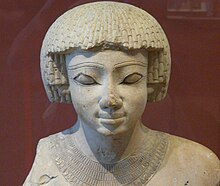Ahmose Sapair
| Ahmose-Sapair Prince of Egypt | |
|---|---|
 Ahmose-Sapair at the Louvre (E 15682) | |
| Dynasty | Seventeenth Dynasty of Egypt |
| Pharaoh | Seqenenre Tao to Ahmose I |
| Father | Seqenenre Tao or Ahmose I |
| Burial | Thebes |
Ahmose-Sapair (also -Sipair) was a prince of the late Seventeenth Dynasty of Egypt (1580 to 1550 BCE). He was probably a son of Pharaoh Seqenenre Tao and a brother of Ahmose I[1] or the child of Ahmose I.[2]
| ||||||||
| Ahmose-Sapair | ||||||||
|---|---|---|---|---|---|---|---|---|
| Era: New Kingdom (1550–1069 BC) | ||||||||
| Egyptian hieroglyphs |
During the Eighteenth Dynasty, he appears on several monuments. Such prominence is relatively rare in case of princes who never ascended to the throne, so it has been suggested that he might be identical with the unknown father of Thutmose I, who succeeded Sapair's nephew, the childless Amenhotep I.[1] However, the mummy identified as his is that of a 5- to 6-year-old boy. The mummy was found in the Deir el-Bahari cache (DB320) in 1881 and was unwrapped by Grafton Elliot Smith and A. R. Ferguson on September 9, 1905.[3]
The location of his tomb is unknown, however it was still known during the inspection of tombs from the Twentieth Dynasty mentioned on the Abbott Papyrus.[2]
References[]
- ^ a b Dodson, Aidan; Hilton, Dyan (2004). The Complete Royal Families of Ancient Egypt. London: Thames & Hudson. ISBN 0-500-05128-3., p.129
- ^ a b Wente, Edward F. Thutmose III's Accession and the Beginning of the New Kingdom. p. 271 . Journal of Near Eastern Studies, University of Chicago Press, 1975.
- ^ The mummy of Ahmose-Sipair
External links[]
| Wikimedia Commons has media related to Ahmose Sapair. |
- His coffin and mummy[permanent dead link]
- Princes of the Seventeenth Dynasty of Egypt
- Princes of the Eighteenth Dynasty of Egypt
- Ancient Egyptian mummies